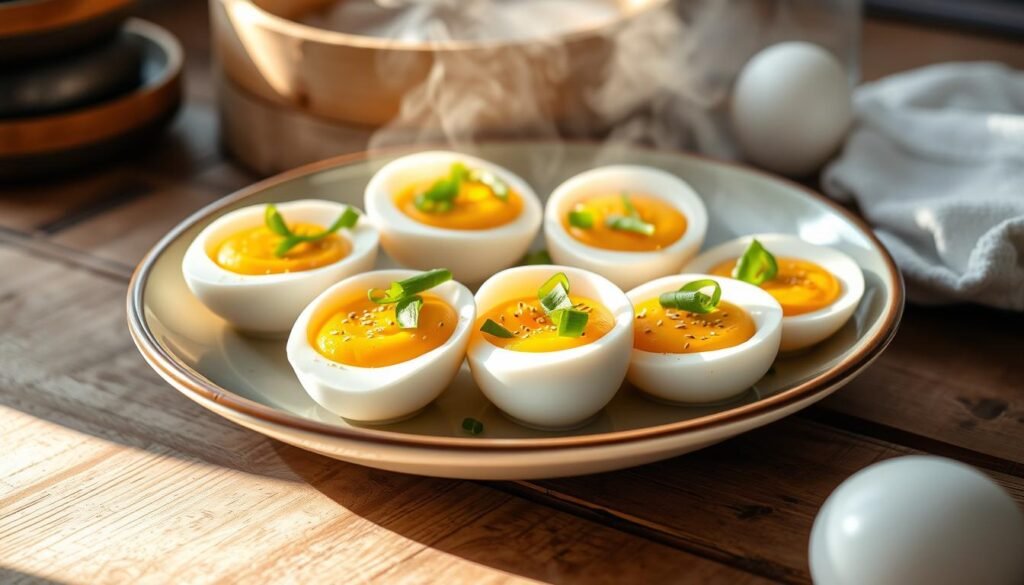
Learning to make steamed egg is a great way to add a tasty and healthy dish to your meals. It’s easy to make and full of nutrients. We’ll show you how to make perfect steamed eggs with a simple recipe and ingredient list.
Whether you want a traditional Chinese steamed egg or something with your own twist, we’ve got you covered. We’ll guide you through each step, making it easy to follow.
By following our simple steps and using our recipe, you’ll make a dish that’s both delicious and healthy. Let’s start and learn how to make steamed egg that you’ll love. Our guide is easy to follow, so you can make a Chinese steamed egg or your own version with confidence.
Understanding Steamed Egg: A Traditional Asian Delicacy
Steamed eggs have a rich history and cultural significance across many Asian countries. From Japan’s fluffy steamed eggs to China’s savory ones, each place has its own twist. Knowing their origins and regional variations is key to enjoying steamed eggs fully.
Steamed eggs are not just tasty but also healthy and low in calories. They’re great for those who want a guilt-free meal. Their health benefits and versatility make them a favorite in many Asian cultures.
Origins and Cultural Significance
Steamed eggs have been around for centuries in ancient Chinese and Japanese cuisines. They were seen as symbols of good fortune and prosperity. Today, they remain a beloved dish in many Asian countries, with each adding its own flavor.
Different Regional Variations
Every region has its own version of steamed eggs. For example, Korea’s spicy steamed eggs and Thailand’s delicate, savory ones. Some popular variations include:
- Japanese steamed eggs with soy sauce and ginger
- Chinese steamed eggs with mushrooms and scallions
- Korean steamed eggs with chili flakes and garlic
Health Benefits of Steamed Eggs
Steamed eggs are packed with protein, vitamins, and minerals. They’re a healthy choice for those seeking a nutritious meal. Whether you like them fluffy or with toppings, they’re both delicious and good for you.
Essential Ingredients and Equipment for Perfect Steamed Eggs
To make a delicious asian steamed egg, you’ll need the right stuff. You’ll need eggs, water, and seasonings like salt and soy sauce. The quality of your ingredients will affect the taste and texture of your steamed eggs.
A basic steamed egg recipe needs just a few things. But, you also need the right tools. You’ll need a steamer, a heatproof bowl or plate, and a lid. The steamer can be a traditional bamboo steamer or a modern electric steamer.
Here’s a list of the essential ingredients and their quantities:
- 2 eggs
- 1/2 cup water
- 1/4 teaspoon salt
- 1/4 teaspoon soy sauce (optional)
You can adjust the quantities based on the number of people you’re serving and your personal preferences.
For a creamy steamed egg custard, use room temperature eggs. Whisk them well before adding the water and seasonings. The key to a smooth custard is to cook the eggs gently and not to overcook them.

With the right ingredients and equipment, you’re ready to start making your own delicious steamed eggs. Remember to experiment with different seasonings and ingredients to create your own unique steamed egg recipe.
How to Make Steamed Egg: The Basic Method
To make delicious steamed eggs, follow a few simple steps. Start by cracking eggs into a bowl and whisking them with a fork. This step is key in the easy steamed egg method. It makes the eggs light and fluffy.
Next, find the perfect egg-to-water ratio. Too much water makes eggs runny, too little makes them dense. Use about 1 cup of water for every 2 eggs. Adjust this ratio to your liking, but this is a good starting point for the best steamed egg.
Preparing Your Eggs
When preparing your eggs, use fresh and high-quality steamed egg ingredients. Choose farm-fresh eggs and purified water. You can also add a pinch of salt or other seasonings to taste.
The Perfect Egg-to-Water Ratio
Once your eggs are ready, it’s time to steam them. To get the perfect egg-to-water ratio, follow these tips:
- Use a steamer basket to hold the eggs, as this helps to distribute the heat evenly.
- Make sure the water level is below the bottom of the steamer basket, as this helps to prevent the eggs from becoming too runny.
- Use a timer to ensure that the eggs are steamed for the right amount of time. This will help you to achieve the perfect texture and consistency.
Setting Up Your Steaming Station
To make a delicious steamed egg, you need to set up your steaming station properly. This means choosing the right equipment and making sure it’s clean and ready. A quick steamed egg tutorial will help you, but knowing the basics of steaming is key.
When setting up, think about the type of steamer you’re using. You can pick a traditional steamer or a modern electric steamer. Each has its own pros and cons. Here are some things to consider:
- Space: If your kitchen is small, a compact electric steamer might be better.
- Ease of use: Electric steamers are simpler to use, with preset timers and controls.
- Cost: Traditional steamers are often cheaper, but they need more effort to use.
After picking your steamer, follow the manufacturer’s setup and use instructions. This ensures safe and efficient use. With practice, you’ll soon be making tasty steamed eggs. A quick steamed egg tutorial will be your trusted guide.

By following these tips and using the right equipment, you’ll make a delicious steamed egg. Always follow safety guidelines when steaming. Don’t be afraid to try new recipes and ingredients to find your favorite.
| Steamer Type | Advantages | Disadvantages |
|---|---|---|
| Traditional Steamer | Affordable, easy to clean | Requires more effort to use, limited temperature control |
| Electric Steamer | Easy to use, preset timers and temperature controls | More expensive, takes up more space |
The Steaming Process: Timing and Temperature Control
To make the perfect steamed egg asian style, you must understand timing and temperature. Cooking at the right temperature for the right time is crucial. This ensures a best steamed egg.
A steamed egg dish is delicate. Overcooking or undercooking can ruin its texture and taste. To get it just right, control the heat and steam levels. Here are some tips for the perfect steamed egg asian style:
Proper Heat Settings
Use a medium heat setting for gentle steam. This cooks the eggs evenly, avoiding them from being too runny or hard.
Steaming Duration Guide
The steaming time varies based on egg number and desired doneness. Here’s a general guide:
- 2-3 minutes for soft and runny eggs
- 4-5 minutes for medium-cooked eggs
- 6-7 minutes for hard-cooked eggs
Testing for Doneness
To check if your steamed egg dish is done, remove it from the steamer. Gently press the egg with your finger. If it’s soft and runny, it’s not done. If it’s firm and springy, it’s perfect.
Common Mistakes to Avoid When Making Steamed Eggs
Making homemade steamed eggs can be exciting. But, even with a good guide, mistakes can still happen. Knowing common pitfalls helps ensure your eggs turn out right every time.
Watch out for overcooking, using the wrong eggs, and not enough water. Overcooking makes eggs rubbery. Wrong eggs change flavor and texture. Always follow a trusted recipe and use fresh, quality ingredients.
Here are some tips to remember:
- Use gentle heat to prevent eggs from cooking too fast
- Don’t overcrowd the steamer to avoid eggs sticking together
- Use a timer to cook eggs for the right time
By following these tips, you can make delicious homemade steamed eggs. Whether you’re experienced or new, practice and patience will help you make perfect steamed eggs.

The secret to great steamed eggs is fresh, quality ingredients and a trusted recipe. With practice and patience, you’ll soon enjoy homemade steamed eggs.
Delicious Variations and Toppings
Steamed eggs offer endless possibilities. You can have them as a simple easy steamed egg dish or add your own twist with toppings. To explore how to make steamed egg with new flavors, try Asian garnishes or modern mixes.
Start with a steamed eggs recipe and then add your favorite ingredients. You can add mushrooms, soy sauce, or proteins for a unique taste.

- Traditional Asian garnishes like green onions and sesame seeds
- Modern flavor combinations like truffle oil and parmesan cheese
- Vegetarian options like roasted vegetables and tofu
Exploring these variations can help you find your favorite steamed egg dish. It can become a regular part of your meals.
Storage and Reheating Tips
To keep your chinese steamed egg fresh, store it right. Put steamed eggs in an airtight container in the fridge for up to 3 days. When reheating, use gentle heat to avoid overcooking.
For a fluffy steamed egg, reheat it carefully. You can steam it again for a few minutes or microwave it briefly. Be careful not to overheat, as it can make the eggs rubbery. For more tips on making the perfect steamed egg with toppings, check out online recipes and techniques.
Here are some tips for reheating steamed egg with toppings:
- Use a microwave-safe container to reheat the eggs.
- Reheat the eggs in short intervals, checking on them until they’re warmed through.
- Avoid overheating, as this can cause the eggs to become tough.

By following these tips, you can enjoy your chinese steamed egg for longer. It will keep its texture and flavor.
Conclusion: Mastering the Art of Steamed Eggs
Making the perfect steamed eggs is an art that needs practice and detail. By following the steps here, you’re on your way to becoming a master. Whether you like the healthy steamed egg or the savory steamed egg, the key is to use asian steamed egg techniques and be creative.
The beauty of steamed eggs is their simplicity and versatility. Try different flavors, toppings, and ways to present them. With time and patience, you’ll make silky-smooth, perfectly cooked steamed eggs every time.
So, what are you waiting for? Get your ingredients ready, fire up your steamer, and impress your family and friends. Bon appétit!
